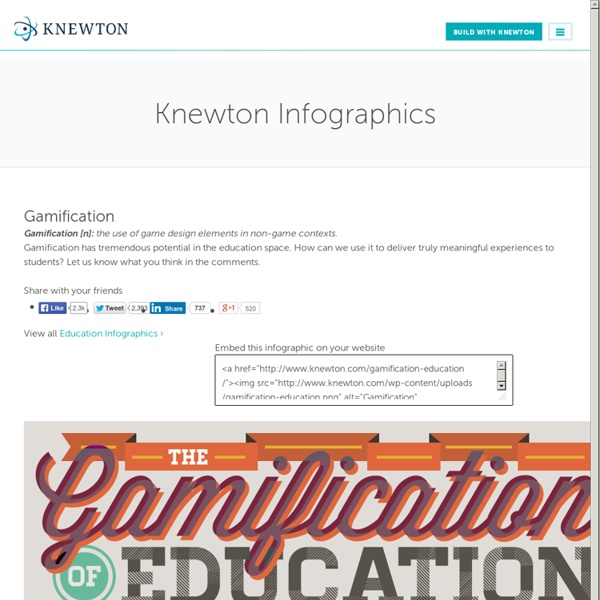



http://www.knewton.com/gamification-education/
Related: 21st century teaching and learningReport highlights 10 trends set to shake up education Massive open social learning and dynamic assessment on the Open University’s list The Open University has published the Innovating Pedagogy 2014 report, which explores new forms of teaching, learning and assessment. It proposes 10 innovations that, although already established to some extent, have not yet had what it describes as “a profound influence” on education. Turn Pictures Into Stories With Fotobabble This morning I shared an old post about Fotobabble on the Free Technology for Teachers Facebook page. In response to that post Stewart Whitney shared his experience of using the Fotobabble iPhone app. Stewart's comment got me to try the Fotobabble iOS app. Fotobabble is a free service that allows you to quickly turn a picture into an audio picture story.
Gamification increases engagement and retention levels Gamification is on the rise and has become one of business’ recent buzzwords. But what are we talking about? Defined as the use of game design mechanisms in non-gaming contexts, the term gamification was first introduced in 2002 by computer programmer Nick Pelling. What is Gamification? Gamification is the concept of applying game mechanics and game design techniques to engage and motivate people to achieve their goals.[1] Gamification taps into the basic desires and needs of the users impulses which revolve around the idea of Status and Achievement. The research company Gartner predicts that by 2015, a gamified service for consumer goods marketing and customer retention will become as important as Facebook, eBay, or Amazon, and more than 70% of Global 2000 organizations will have at least one gamified application. [2] History The oldest example of gamification are Frequent Flyer Programs that airline companies offer as a part of their customer loyalty programs. Gamification was a term that was first coined in 2003 by Nick Pelling, but did not gain popularity until 2010.[3] The term gamification began to gather interest and a following in 2010 when companies such as Badgeville started using it to describe their behavior platforms.
2014 Reflections on Gamification for Learning The year 2014 was a fantastic year for gamification with lots of companies engaging in gamified solutions, more and more people understanding what gamification is all about and several well known technology companies taking the plunge into gamification. As well as some interesting vendor offerings in the field. The interest in gamification for learning is larger than it’s ever been and continues to grow (but not as fast as some predicted…more about that later). This year I found myself traveling to Mexico to help with gamification projects, visiting California to conduct several gamification workshops for technology and biotech companies, writing an academic book chapter on gamification, creating a Lynda.com course on gamification and speaking about the topic with many people at conferences and within their own organizations. Here are some thoughts and reflections based on those experiences:
Visitors and Residents: What Motivates Engagement with the Digital Information Environment? Building on research of individuals’ modes of engagement with the web (Visitors and Residents4), and the JISC-funded Digital Information Seeker report5, this project is exploring what motivates different types of engagement with the digital environment for learning. The investigation focuses on the sources learners turn to in order to gather information, and which ‘spaces’ (on and offline) they choose to interact in as part of the learning process. It is using the Visitors and Residents6 framework to map learner’s modes of engagement in both personal and institutional contexts. The project is assessing whether individual’s approaches shift according to the learners’ educational stage or whether they develop practices/literacies in early stages that remain largely unchanged as they progress through their educational career. The pilot phase focused on the ‘Emerging’ educational stage which spans late stage secondary school and first year undergraduates.
Batalugu Create Your Own Don't just buy books at a store, write your own and personalize it. Read & Enjoy! 5 Free Gamification Ideas: Motivate Your Employees The Old-fashioned Way Going from good to great in the workplace often means employing gamification to motivate your workforce. Pay and perks or plain supervisor authority aren’t enough: you need to stoke people’s internal fire with drive and purpose. Gamification, the use of game mechanics to alter behavior is a great way to do this, since it taps into the deepest drives that make us human: the need to do well, to feel a sense of purpose and to understand the story we’re in. There are many gamification offerings; some use the old school points and badges. Others use more modern approaches, using narrative based games that tie seamlessly into corporate applications. But in this post I want to take on offline, old –fashioned and timeless games and apply them to workforce motivation.
L'infografica delinea in maniera chiara il processo della Gamification negli Usa e la sua insospettabile popolarità tra i giovani. La sua utilità può impattare soprattitto agli studenti in difficoltà di apprendimento con metodi tradizionali by nymeria Mar 13
Infographie TRES intéressante sur la gamification de l'éducation. Elle explique les enjeux, les principes et l'histoire de celle ci, plus particulièrement aux Etat-Unis. by nicolastridemy Apr 4